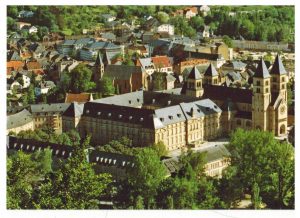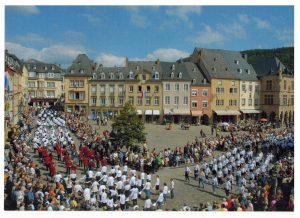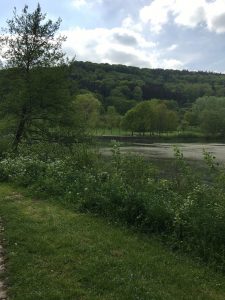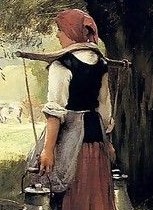 After an exceptionally long winter that dragged on into April, May burst forth with enough vigour to drench the countryside with a top coat of pollen that looked like a layer of golden muslin. Now, the countryside is lush and fecund: the woods are dense with vivid green leaves, the fields are abloom with wheat and wildflowers. Today, I caught the bus north-east to Echternach, to watch the annual Sprangpressessioun or Spring Procession with a group of girlfriends. It was an extraordinary, enchanting experience.
After an exceptionally long winter that dragged on into April, May burst forth with enough vigour to drench the countryside with a top coat of pollen that looked like a layer of golden muslin. Now, the countryside is lush and fecund: the woods are dense with vivid green leaves, the fields are abloom with wheat and wildflowers. Today, I caught the bus north-east to Echternach, to watch the annual Sprangpressessioun or Spring Procession with a group of girlfriends. It was an extraordinary, enchanting experience.
Echternach is a pretty, medieval town that sits beside the River Sauer. Across the river is Germany. In the centre of town is the Echternach Abbey, founded in 698 A.D. by an English monk, Willibrord. Although the town was badly damaged in World War II, it was largely restored by 1953 and some sections of the medieval walls and towers remain intact.
The Echternach Sprangpressessioun takes place on Whit Tuesday, a religious holiday in Catholic Luxembourg, seven weeks after Easter. The Spring Procession, or Hopping Parade as it is commonly known, has its origins in the 8th century. Its meaning is lost in legend, and may well have evolved from pagan traditions, but in the eighth century, a few years after Saint Willibrord’s death in 739 A.D., pilgrims began to visit his tomb, where it was rumoured many miracles of healing had taken place. Today, hundreds of Luxembourgers parade through the town to honour the local saint, buried in the crypt of the Basilica. The event now attracts so many spectators it was listed in 2010 as Intangible Cultural Heritage by UNESCO.
*
I arrive early with friends, and we set up camp on the steps of the monument in the Market Square. From here we are assured a bird’s eye view of the aptly named Hopping Parade. As the crowds straggle into town, the sick and elderly line the route in their wheelchairs, people lean from upper windows, others make themselves comfortable at the many pavement cafés.
The celebrations began last night with a service at the Basilica. Pilgrims arrive from Germany in time for high mass  at 8 a.m., having set out on foot at noon on Whit Sunday. The Archbishop of Luxembourg makes a speech outside the Abbey at 9.15 a.m.
at 8 a.m., having set out on foot at noon on Whit Sunday. The Archbishop of Luxembourg makes a speech outside the Abbey at 9.15 a.m.
The procession quietly gets underway at 9.30 am, led by a group of church dignitaries, policemen and firemen. Church servers carry banners and the cross. Singers chant the litany. Pilgrims recite the rosary. Then come the first hoppers. The program lists thirty-eight groups from churches, Scout groups and schools in Luxembourg, Germany and even Ireland.
The bands – mostly brass and wind – march through the streets, top and tailed by rows of ‘hoppers’. In lines of five or six, each hopper grasps the corner of a triangular white bandana. As the band begins to play the traditional marching tune ‘Sprangprëssessioun,’ the hoppers perform what looks like a slow polka, hopping two steps to the left and two to the right, gradually moving across the square.
All the hoppers are wearing white tops and dark skirts or trousers. Bandanas around the neck are mostly white, but are occasionally interspersed with green, blue or yellow. Ages range from five to eighty-five. A note on the program reminds spectators that this is a religious procession, not a folk festival, so please refrain from clapping. And so, we watch solemnly as the parade weaves slowly through the town to the song that never ends. Eventually, however, it does end – four hours later, when every one of those thirty-eight groups has processed around the town, through the Basilica and down into the crypt, past Saint Willibrord’s grave. And at last we are free to run from the sun, dodge down a back street and find a table at one of the many restaurants, joining hundreds of white-topped hoppers gasping for food and beer.
*
I have visited Echternach several times before, and while the crowds are never quite as large as they are today, sunny summer weekends will usually find the cafés and restaurants packed tight for leisurely Sunday lunches. On the outskirts of town, down by the man-made lake, picnickers sprawl on the lawns, play ball games, ride bikes, pedal on paddle boats.
 Earlier this month, however, I found myself meandering around the lake in the middle of the week, one of only a handful of nature lovers to be seen. For once, humans were outnumbered by bird life: numerous ducks, a crane, three swans and a pair of Mandarin ducks. The day was warm and peaceful. I sat quietly under a tree and watched the world go by.
Earlier this month, however, I found myself meandering around the lake in the middle of the week, one of only a handful of nature lovers to be seen. For once, humans were outnumbered by bird life: numerous ducks, a crane, three swans and a pair of Mandarin ducks. The day was warm and peaceful. I sat quietly under a tree and watched the world go by.
Heading home, I decided to veer off the main road – an otherwise straight line to our front door – and go cross-country, following my nose down rural lanes that corkscrew and curl like a roller coaster. These winding roads pass through rural villages cluttered with boxy houses in a rainbow assortment of lilac and ochre, rose pink and denim blue. Small churches point narrow spires to the airplane tracks across the sky. Swooping over a rise, I looked down on a village nestled into the crook of thickly wooded hills.
I drove past a grizzled farmer riding his burly tractor through a field of freshly mown hay, and meadows spotted with yolk-yellow buttercups and dandelion clocks. The road wound up and over the curvaceous contours of Rubenesque hills. There were so many shades of green I would need the skills of an artist to describe them in paint. Cinnabar, cadmium, viridian, emerald and olive: names of oil paints that weave a cloying spell you can almost taste.
Speckled cows had gleefully escaped their winter barns to gorge on thick grass among the pastel-pink blossom of  squat apple trees, and sturdy donkeys leaned over the fence, happy to chat with passers-by. The highland cattle that, in winter, had posed by the road buried knee deep in muddy hay, had now drifted up the slopes, dipping their long horns like Dupre milk-maids. Raptors soar and swoop in search of prey, or simply for the fun of riding the air currents. I am smitten with the landscape and the clear blue skies. Its enough to make you want to hop and skip through the buttercups…
squat apple trees, and sturdy donkeys leaned over the fence, happy to chat with passers-by. The highland cattle that, in winter, had posed by the road buried knee deep in muddy hay, had now drifted up the slopes, dipping their long horns like Dupre milk-maids. Raptors soar and swoop in search of prey, or simply for the fun of riding the air currents. I am smitten with the landscape and the clear blue skies. Its enough to make you want to hop and skip through the buttercups…
*The photos were borrowed from Google images (Dupre’s milkmaid), postcards by Peuky Barone-Wagener and my own view of the lake at Echternach.
